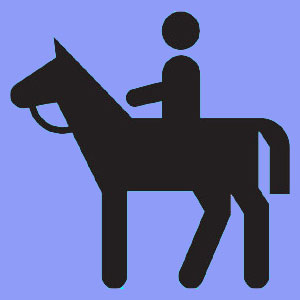
Horseback riding sciatica describes buttocks and leg pain syndromes that are caused or exacerbated by riding a horse. Equestrians often suffer chronic buttocks, leg or foot pain that is related to their favorite passion of riding. Of course, this is still a kind fate when compared to riders who face significant injury from serious falls and tramples.
Sciatica is known to flare-up when pressure is applied to the region surrounding the sciatic nerve. This means that virtually any seated activity can prove to be painful. However, since horseback riding also entails constant up and down posting movement in the saddle, as well as spinal impact, the chances of suffering symptoms are greatly elevated.
This study examines the incidence of sciatica in equestrian enthusiasts. We will explain why sciatica is commonly demonstrated in riders, as well as the mechanics that cause it to occur. Finally, we will take a look at some lesser discussed aspects of sciatic nerve symptoms, including the activity-related mindbody contributors that may be linked to certain symptomologies.
Horseback Riding Sciatica Incidence
Sciatica is far more commonplace in the equestrian community than it is in the general population. Since sciatica is already an epidemic occurrence, this fact places the number of serious riders who suffer from sciatica into the astronomical range.
Sciatica is not the only dorsalgia syndrome that affects more horseback riders than it does in the general population at large. Lower back pain is also very common and the number of people diagnosed with intervertebral herniation of one or more spinal discs is proportionately higher among equestrians, as well.
Back injury is a common rider citation, usually reported after a serious fall. Luckily, most injuries are not overly severe and will heal with time and treatment. These types of trauma usually entail bulging discs, back strain, muscle and ligament tears, coccyx bruising and spinal fractures.
More sinister spinal damage can also befall equestrians, such as spinal nerve or spinal cord injury. Many of these occurrences prove fatal each year, while ten times this number will result in life-long physical impairments due to neurological deficits.
Mechanics of Equestrian Sciatica
There are different riding styles, but most, if not all, place exaggerated stress on the sciatic nerve. Posting up and down in the saddle can lead to neurological irritation, while the postural requirements of riding can also prove to be detrimental for some sensitive anatomies.
The constant impact suffered by the buttocks, hips and legs must be tolerated, as well as be magnified into certain anatomical regions, since the legs are often used to grip and control the horse as it moves. These factors can focus trauma directly into the region of the sciatic nerve, causing symptoms, aggravating existing symptoms, exacerbating structural pathologies and extending the duration of preexisting symptomologies.
Ill-fitting saddles and a poor fit in horse can both make matters worse, especially for some styles of equestrianism. Likewise, improper riding technique or an uncooperative mount can also increase the risk of suffering injury or pain from any riding session.
Horseback Riding Sciatica Discussions
On the positive side, equestrians generally adore their horses and will pursue perfection in their riding passion, despite their pain. Very few riders have reported ceasing to participate in their favorite pastime just because of sciatica or lower back pain. This obviously implies that the mindbody benefits gained far outweigh the pain suffered.
On a related note, it is also common for serious riders to suffer increased pain or chance of injury when preparing for competition or in the actual competition itself. Of course, this is common in all virtually sports and might surely involve the psychoemotional strain of competition just as much as the physical and anatomical consequences of the exertion itself.
In order to help minimize the risks of suffering injury while horseback riding, be sure that all equipment is in good repair, is properly sized and is properly utilized. Keeping time spent in the saddle within commonsense guidelines can also help to reduce the burden on the sciatica nerve anatomy. Wearing padded riding pants, or slightly adjusting saddle technique, might help some riders to experience less pain.
Finally, it is wise to consider emotional factors that might be adding stress to the body through the buildup of tension. These can include pressure to perform and compete, the financial expense of riding or maintaining a horse and any other possible nonphysical detail that might heighten the risk of pain or injury while riding.
All in all, equestrians are blessed with a love for a wonderful partnership between man and animal. They work diligently to develop the skills and aptitudes to ride flawlessly, but also cultivate wonderful relationships with their steeds. Most will accept the potential downside of these choices, such as sciatica, with open arms. However, when the pain becomes truly problematic and begins to affect life outside of the saddle, some changes might need to be made to continue to enjoy the passion, without becoming a casualty to it.
For more information about riding safely and comfortably, talk to your physical therapist or a sports medicine physician who has unique experience dealing with equestrian-related spine and nerve issues.





